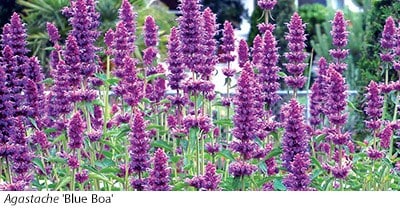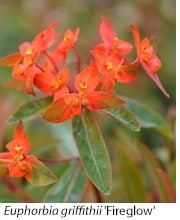Choosing your perennials
The trick is to select the very best plants, because most of us haven’t got space for the also rans or frankly the poor. We want the crème de la crème, the plants that not only look lovely but perform for a long time. We want them to return year after year and be good neighbours, ones that won’t muscle in on other things. With this in mind, it always helps to look for an AGM award, as this is a reliable indicator of a great plant.
Learn to love colour when choosing plants, because the days of the pastel English country garden that looks like a watercolour painting have largely gone. Also, try to avoid planting only one of each thing as this will resemble a pincushion of dots. Far better to plant in threes, fives or sevens, always odd numbers, and avoid forming cloud-like blobs. Make a triangular shape, or a narrow ribbon that looks like its waving in the wind. This is much more pleasing on the eye.
Evening Stars

Blue is a touch-paper colour if used with orange and yellow and it stands out in dusk like the evening star. However it’s a rare phenomenon in garden plants, so you have to work at adding an infusion. Good blues, with a long flowering season, include Agastache. These aromatic plants have blue flowers that vary from the slender black-stemmed, violet-flowered ‘Blackadder’, to the softer-hued bottle brushes of ‘Blue Fortune’. A new, shorter agastache called ‘Blue Boa’ combines pink-lavender flowers emerging from a maroon-red spike. Useful plants, which survive well in reasonably drained soil, they provide upright verticals in strong blue, black and violet. Cut them down in spring in colder districts and try to find well-drained places.
 Veronicas (the herbaceous ones), were a garden staple before they were upstaged by taller, later-flowering veronicastrums planted in the Piet Oudolf style. However there are some new veronicas and they include V. spicata ‘Royal Candles’ a vibrant foot-high perennial with bright green foliage and bright blue flowers. The tapering candles combine deep blue and bright green, a summer-fresh combination and, when deadheaded, more flowers appear. Use close to roses with either yellow, orange or deep pink flowers, because the two will overlap and flatter each other.
Veronicas (the herbaceous ones), were a garden staple before they were upstaged by taller, later-flowering veronicastrums planted in the Piet Oudolf style. However there are some new veronicas and they include V. spicata ‘Royal Candles’ a vibrant foot-high perennial with bright green foliage and bright blue flowers. The tapering candles combine deep blue and bright green, a summer-fresh combination and, when deadheaded, more flowers appear. Use close to roses with either yellow, orange or deep pink flowers, because the two will overlap and flatter each other.
Blue and violet-blue look tremendous in a woodland setting especially situated close to the spring-flowering mound of Euphorbia epithymoides (once E. polychroma). It’s the earliest of the deciduous spurges to perform and, in order to make it truly perennial, it should be cut back after flowering so that it produces new growth at the base. Care always needs to be taken when cutting back euphorbias because their latex-like sap is an irritant to the skin and it can damage your eyes in severe cases.

The acid yellow bracts of E. epithymoides last for many weeks and it’s biddable enough to flower in some shade. Team it with the deep blue, green-leaved Pulmonaria ‘Blue Ensign’. This doesn’t appear to set seed (as so many pulmonarias do) and it’s interesting from the moment it leaves the ground, with purple shoots that thrust through the soil like space rockets. The flowers are almost gentian-blue in intensity. For intense violet flowers opt for Pulmonaria 'Trevi Fountain' and you’ll also get silver-spotted foliage as well. Both are in the top rank of pulmonarias and deserve a place in every garden.
 Later in the year lots of deciduous euphorbias will provide a cloud of acid-yellow and among the best is E. palustris, a June performer that enjoys good soil. 'Walenburg's Glorie' is a selected brighter yellow form. Or you might prefer the fiery orange bracts and foliage of E.griffithii ‘Fireglow’, a plant that creeps a little maybe, but is enormously useful in dank corners of the garden where nothing much flourishes. The asparagus-like spears of fiery apricot-orange pierce the earth in mid-spring and flowers follow in May, often coinciding with late tulips.
Later in the year lots of deciduous euphorbias will provide a cloud of acid-yellow and among the best is E. palustris, a June performer that enjoys good soil. 'Walenburg's Glorie' is a selected brighter yellow form. Or you might prefer the fiery orange bracts and foliage of E.griffithii ‘Fireglow’, a plant that creeps a little maybe, but is enormously useful in dank corners of the garden where nothing much flourishes. The asparagus-like spears of fiery apricot-orange pierce the earth in mid-spring and flowers follow in May, often coinciding with late tulips.
Bright splashes of gold are useful in dank corners, but they can look sickly in bright light. Dark foliage, on the other hand, shines in sunlight and sets off flowers of any colour. Sedum ‘Purple Emperor’ should be at the top of everyone’s ‘dark, dusky and interesting’ wish list because the neat foliage is dark from the word go: other sedums take their time to colour and darken. The neatly crimped foliage, which is smoky and plump, stays pristine and this foot-high plant doesn’t split at the crown so it can stay undivided for many years. The deep pink flowers shine in August, earlier than many sedums, and they are bee-friendly. And not all sedums are!







